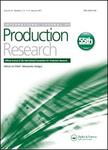版权所有:内蒙古大学图书馆 技术提供:维普资讯• 智图
内蒙古自治区呼和浩特市赛罕区大学西街235号 邮编: 010021

作者机构:Univ Luton Fac Creat Arts Technol & Sci Luton LU1 3JU Beds England Univ Loughborough Mechatron Ctr Wolfson Sch Management & Mfg Engn Loughborough LE11 3TU Leics England
出 版 物:《INTERNATIONAL JOURNAL OF PRODUCTION RESEARCH》 (国际生产研究杂志)
年 卷 期:2005年第43卷第15期
页 面:3247-3272页
核心收录:
学科分类:12[管理学] 120202[管理学-企业管理(含:财务管理、市场营销、人力资源管理)] 0202[经济学-应用经济学] 02[经济学] 1202[管理学-工商管理] 1201[管理学-管理科学与工程(可授管理学、工学学位)] 0802[工学-机械工程]
主 题:process sequencing features generic algorithm neural network optimization
摘 要:Operation sequencing has been a key area of research and development for computer-aided process planning (CAPP). An optimal process sequence could largely increase the efficiency and decrease the cost of production. Genetic algorithms (GAs) are a technique for seeking to `breed good solutions to complex problems by survival of the fittest. Some attempts using GAs have been made on operation sequencing optimization, but few systems have intended to provide a globally optimized fittest function definition. In addition, most of the systems have a lack of adaptability or have an inability to learn. This paper presents an optimization strategy for process sequencing based on multi-objective fittness:minimum manufacturing cost, shortest manufacturing time and best satisfaction of manufacturing sequence rules. A hybrid approach is proposed to incorporate a genetic algorithm, neural network and analytical hierarchical process (AHP) for process sequencing. After a brief study of the current research, relevant issues of process planning are described. A globally optimized fittness function is then defined including the evaluation of manufacturing rules using AHP, calculation of cost and time and determination of relative weights using neural network techniques. The proposed GA-based process sequencing, the implementation and test results are discussed. Finally, conclusions and future work are summarized.